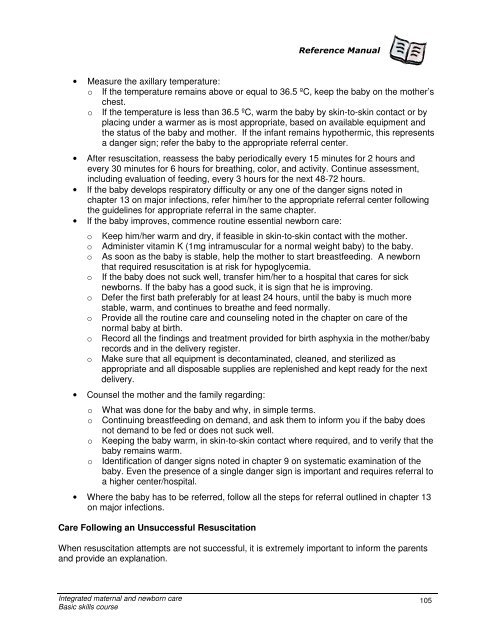Integrated Maternal and Newborn Care Basic Skills Course ...
Integrated Maternal and Newborn Care Basic Skills Course ...
Integrated Maternal and Newborn Care Basic Skills Course ...
Create successful ePaper yourself
Turn your PDF publications into a flip-book with our unique Google optimized e-Paper software.
Reference Manual<br />
• Measure the axillary temperature:<br />
o If the temperature remains above or equal to 36.5 ºC, keep the baby on the mother’s<br />
chest.<br />
o If the temperature is less than 36.5 ºC, warm the baby by skin-to-skin contact or by<br />
placing under a warmer as is most appropriate, based on available equipment <strong>and</strong><br />
the status of the baby <strong>and</strong> mother. If the infant remains hypothermic, this represents<br />
a danger sign; refer the baby to the appropriate referral center.<br />
• After resuscitation, reassess the baby periodically every 15 minutes for 2 hours <strong>and</strong><br />
every 30 minutes for 6 hours for breathing, color, <strong>and</strong> activity. Continue assessment,<br />
including evaluation of feeding, every 3 hours for the next 48-72 hours.<br />
• If the baby develops respiratory difficulty or any one of the danger signs noted in<br />
chapter 13 on major infections, refer him/her to the appropriate referral center following<br />
the guidelines for appropriate referral in the same chapter.<br />
• If the baby improves, commence routine essential newborn care:<br />
o Keep him/her warm <strong>and</strong> dry, if feasible in skin-to-skin contact with the mother.<br />
o Administer vitamin K (1mg intramuscular for a normal weight baby) to the baby.<br />
o As soon as the baby is stable, help the mother to start breastfeeding. A newborn<br />
that required resuscitation is at risk for hypoglycemia.<br />
o If the baby does not suck well, transfer him/her to a hospital that cares for sick<br />
newborns. If the baby has a good suck, it is sign that he is improving.<br />
o Defer the first bath preferably for at least 24 hours, until the baby is much more<br />
stable, warm, <strong>and</strong> continues to breathe <strong>and</strong> feed normally.<br />
o Provide all the routine care <strong>and</strong> counseling noted in the chapter on care of the<br />
normal baby at birth.<br />
o Record all the findings <strong>and</strong> treatment provided for birth asphyxia in the mother/baby<br />
records <strong>and</strong> in the delivery register.<br />
o Make sure that all equipment is decontaminated, cleaned, <strong>and</strong> sterilized as<br />
appropriate <strong>and</strong> all disposable supplies are replenished <strong>and</strong> kept ready for the next<br />
delivery.<br />
• Counsel the mother <strong>and</strong> the family regarding:<br />
o What was done for the baby <strong>and</strong> why, in simple terms.<br />
o Continuing breastfeeding on dem<strong>and</strong>, <strong>and</strong> ask them to inform you if the baby does<br />
not dem<strong>and</strong> to be fed or does not suck well.<br />
o Keeping the baby warm, in skin-to-skin contact where required, <strong>and</strong> to verify that the<br />
baby remains warm.<br />
o Identification of danger signs noted in chapter 9 on systematic examination of the<br />
baby. Even the presence of a single danger sign is important <strong>and</strong> requires referral to<br />
a higher center/hospital.<br />
• Where the baby has to be referred, follow all the steps for referral outlined in chapter 13<br />
on major infections.<br />
<strong>Care</strong> Following an Unsuccessful Resuscitation<br />
When resuscitation attempts are not successful, it is extremely important to inform the parents<br />
<strong>and</strong> provide an explanation.<br />
<strong>Integrated</strong> maternal <strong>and</strong> newborn care<br />
<strong>Basic</strong> skills course<br />
105

















